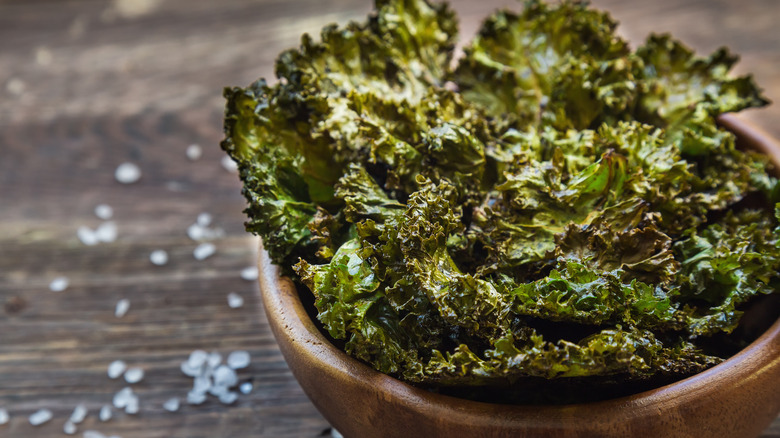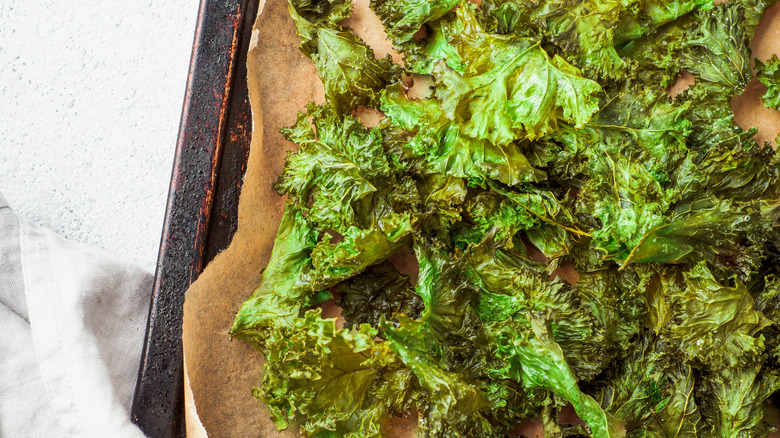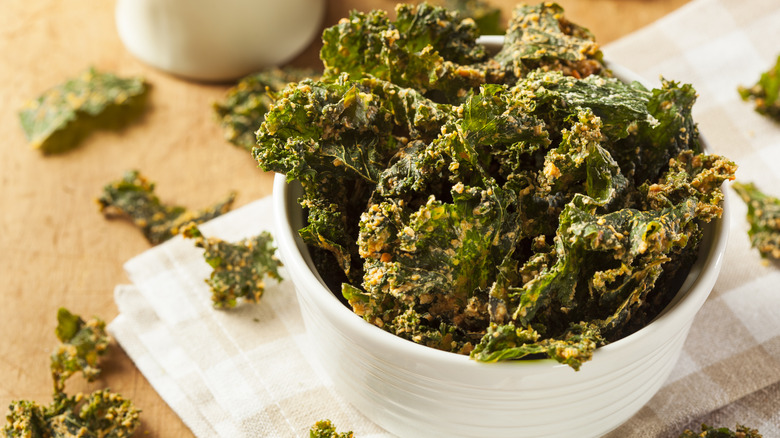For The Absolute Best Kale Chips, Watch Your Oven Temperature
Kale is arguably the poster child for currently trendy superfoods. This isn't to say it isn't healthy — kale can walk the walk regarding nutrition. This dark, leafy cousin of cabbage, is loaded with vitamins C and K, antioxidants, and a lot of bulk and fiber. But kale isn't universally embraced like lettuce or other salad greens are; its fibrous stem and burly leaves can be difficult to tenderize, and, in turn, digest. Sure, there are ways to make kale a little more toothsome — you can massage the leaves or throw them in a blender, for instance — but these methods often fail to tone down its vegetal aftertaste and overall toughness.
That's why so many home cooks have turned to the kale chip. Kale chips are crispy, nutritious, and absent the guilt often associated with gorging on a bag of potato chips. They're also easy to make — scatter a thin layer of leaves on a sheet pan, drizzle with olive oil, and give them a bake. But even the simplest of recipes leave plenty of room for nuance. One of the most important factors to consider when making kale chips at home is the temperature of your oven. By baking your kale chips low-and-slow, you'll develop a crisp, brittle texture without torching the leaves.
How to prepare a really crispy kale chip
Make a good batch of kale chips and you'll likely become a lifelong fan. However, developing the perfect taste and texture for kale chips requires a bit of preparation. First, you need to deal with your kale. Strip the leaves from their woody stems, give them a rinse under cold water, and spin them dry in a salad spinner. Any moisture that remains will affect the final texture of your chips, so give the leaves extra blotting with a dry paper towel to absorb any remaining dampness. Spread the leaves across a baking pan (be mindful to keep them in one layer) and toss with some olive oil.
Now it's time to bake. The optimum oven temperature for crunchy kale chips is 300 degrees Fahrenheit. By baking at a lower temperature for a longer timeframe (around 20 minutes), the leaves become crispy all the way through. Otherwise, you're likely to singe the outside of the leaves without allowing the centers to dehydrate, which will result in a kale chip with a floppy texture and burnt, bitter flavor. Yes, roasting at a lower temperature does require a little extra patience, but you will be rewarded with a baking tray of kale chips that are crispy, salty, and full of crunch.
Other ways to elevate your kale chips
While baking kale chips at a lower temperature helps develop that desirable crispy texture, there are several ways you can elevate the taste and crunch of kale chips even more. One method is to let your kale chips rest a few minutes after you've pulled them from the oven. As they cool, they'll become firmer and crisper, kind of like a tray of freshly baked cookies.
As far as flavor goes, you can make your kale chips much more interesting by using a blend of spices and seasonings. A squeeze of lemon juice and a sprinkling of Parmesan cheese creates a nice balance of brightness and umami, while a mixture of paprika and brown sugar provides a sweet-and-smoky finish. Other spice blends, like curry powder, Old Bay, za'atar, or toasted nori will add a unique pop to your finished kale chips. Another idea is to serve them alongside a dip, like honey mustard, miso tahini, or chipotle yogurt. As long as you remember to cook your kale chips low-and-slow, finding creative ways to eat them won't be a problem.


